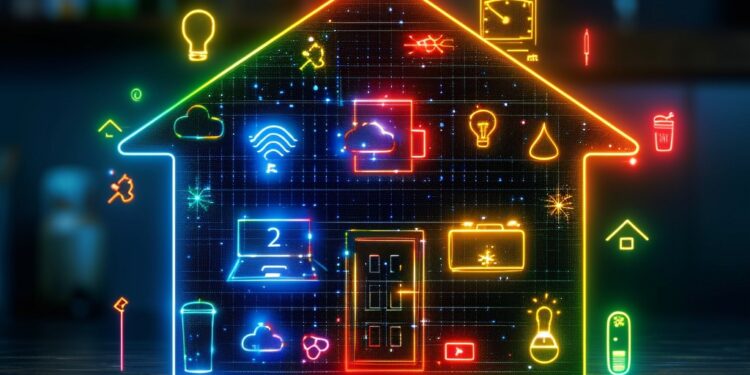Smart Home Automation 2024 dives into the latest advancements and projected trends in the realm of home automation technology, offering a glimpse into the future of smart living. From cutting-edge devices to enhanced security measures, this overview sets the stage for a transformative journey into the world of smart homes.
Smart home automation technology has evolved significantly in recent years, allowing homeowners to control various aspects of their homes remotely. From smart thermostats and lighting systems to security cameras and voice assistants, smart home devices offer convenience, energy efficiency, and enhanced security.
The current state of smart home automation technology is characterized by the widespread adoption of devices that can be controlled via smartphone apps or voice commands. Companies like Amazon, Google, and Apple have developed ecosystems that allow users to connect and control multiple devices through a central hub. Smart speakers, such as Amazon Echo and Google Home, have become popular for their integration with various smart home devices.
Key Trends Expected
1. Increased Integration: By 2024, we can expect even greater integration among smart home devices, enabling seamless communication and automation between different systems.
2. Artificial Intelligence: The use of artificial intelligence (AI) in smart home devices is expected to grow, allowing for more personalized and adaptive automation based on user behavior and preferences.
3. Energy Efficiency: Smart home devices will continue to focus on energy efficiency, with features like energy monitoring and optimization becoming more prevalent.
4. Enhanced Security Features: Security will remain a top priority, with advancements in facial recognition, biometric authentication, and cybersecurity measures to protect smart home systems from hacking and unauthorized access.
Projected Growth
According to market research reports, the smart home automation market is projected to experience significant growth by 2024. Factors such as increased consumer awareness, technological advancements, and the growing demand for connected devices are driving this growth. The market is expected to expand into new segments, such as healthcare and eldercare, further fueling the adoption of smart home automation technologies.
Advancements in Smart Home Devices

Smart home devices have seen remarkable advancements in 2024, offering more convenience, efficiency, and customization options for homeowners. With the integration of AI and machine learning technologies, these devices have become smarter and more intuitive, enhancing the overall home automation experience.
Latest Smart Devices Available
- Smart Thermostats: Advanced thermostats can now learn your temperature preferences and adjust settings automatically to optimize energy consumption.
- Smart Security Cameras: High-definition cameras with facial recognition technology and real-time alerts provide enhanced security monitoring.
- Voice-Activated Assistants: Virtual assistants like Alexa and Google Assistant have become more sophisticated, allowing for seamless control of various smart devices through voice commands.
- Smart Lighting Systems: Energy-efficient LED bulbs that can be controlled remotely via smartphone apps or voice commands, offering customizable lighting options.
Comparison with Previous Years
- Increased Connectivity: Smart devices now offer improved connectivity options, allowing for seamless integration and communication between different devices.
- Enhanced Security Features: The latest smart home devices come with advanced security features like encryption, two-factor authentication, and secure cloud storage.
- Customization Options: Home automation systems in 2024 provide more customization options for users to personalize settings according to their preferences and routines.
AI and Machine Learning Integration
- Personalized Experiences: AI algorithms analyze user behavior and patterns to provide personalized recommendations and automate tasks based on individual preferences.
- Predictive Maintenance: Machine learning algorithms can predict potential issues with smart devices and proactively alert users to take preventive actions, preventing system failures.
- Energy Efficiency: AI-powered smart devices optimize energy usage by learning user habits and adjusting settings to minimize energy waste, leading to cost savings and environmental benefits.
Integration and Interoperability
Smart home automation relies heavily on the integration and interoperability of various devices to work seamlessly together. This is crucial in ensuring that different smart home devices can communicate effectively with each other to provide a cohesive and efficient user experience.
Importance of Integration Among Different Smart Home Devices
Integration among different smart home devices is essential for creating a unified ecosystem where devices can work together to automate tasks, improve energy efficiency, enhance security, and provide convenience to users. Without proper integration, smart home devices would operate in silos, limiting their functionalities and the overall benefits they can offer to homeowners.
- Integration allows devices like smart thermostats, lighting systems, security cameras, and voice assistants to communicate and coordinate their actions, leading to more intelligent and automated home environments.
- Seamless integration also enables users to control multiple devices through a centralized platform or app, simplifying the management of various smart devices in the home.
- Interoperability ensures that devices from different manufacturers can work together, fostering an open ecosystem where users have more flexibility in choosing devices that best suit their needs.
Addressing Interoperability Issues
To tackle interoperability challenges in smart home automation, industry standards and protocols have been established to promote compatibility among different devices. For instance, protocols like Zigbee, Z-Wave, and Thread provide a common language for smart devices to communicate with each other, regardless of the manufacturer.
- Device manufacturers are increasingly adopting open-source platforms and protocols to ensure that their products can interoperate with other devices in the market, promoting a more cohesive smart home ecosystem.
- Initiatives like the Open Connectivity Foundation (OCF) work towards creating a unified standard for IoT devices, enabling seamless communication and interoperability among smart home devices.
- Cloud-based solutions and hubs also play a significant role in bridging the interoperability gap by acting as intermediaries that facilitate communication between devices using different protocols.
Role of IoT
The Internet of Things (IoT) has revolutionized the way smart home devices interact and communicate with each other. By connecting various devices to the internet and enabling them to exchange data, IoT technology enhances the integration and interoperability of smart home systems.
- IoT platforms provide a centralized infrastructure for managing and controlling multiple smart devices, allowing users to create customized automation routines and settings across different devices.
- Interoperability frameworks like IoTivity and AllJoyn facilitate seamless communication among IoT devices, ensuring that smart home systems can work together harmoniously.
- IoT also enables the implementation of advanced features like predictive maintenance, remote monitoring, and data analytics, enhancing the overall performance and efficiency of smart home automation systems.
Security and Privacy Concerns

In the realm of smart home automation, security and privacy concerns have become paramount as more devices are interconnected and data is shared across networks. The vulnerability of these systems to cyber attacks and breaches poses a significant threat to the safety and privacy of homeowners.
Security Challenges Faced
One of the primary security challenges faced by smart home automation systems is the potential for unauthorized access to devices and networks. Weak or default passwords, lack of encryption, and outdated software are common vulnerabilities that hackers can exploit to gain control of smart devices.
- Insufficient Authentication: Many smart home devices lack robust authentication mechanisms, making it easier for hackers to impersonate legitimate users and gain unauthorized access.
- Privacy Risks: The collection and storage of personal data by smart devices raise concerns about data privacy and the potential for misuse or unauthorized sharing of sensitive information.
- IoT Botnets: The rise of IoT botnets, comprised of compromised smart devices, poses a significant threat to the security of smart home networks by enabling large-scale attacks.
Measures to Enhance Security and Privacy
To address the security and privacy concerns in smart home automation, various measures are being implemented to enhance protection and mitigate risks.
The evolution of Fintech and AI has revolutionized the financial industry, offering innovative solutions for digital transactions and financial services. Companies are leveraging advanced technologies to enhance efficiency and security in financial operations. To stay competitive in the digital era, financial institutions need to adapt and integrate AI into their systems.
For more insights on the evolving landscape of Fintech and AI, you can visit Evolving Fintech and AI.
- Strong Authentication: Implementing multi-factor authentication and biometric security measures can help strengthen access control and prevent unauthorized entry.
- End-to-End Encryption: Utilizing encryption protocols to secure data transmission and storage can safeguard sensitive information from interception or tampering.
- Regular Software Updates: Ensuring that smart devices receive timely software updates and patches helps address known vulnerabilities and enhance overall security.
Implications of Data Privacy Regulations
The increasing focus on data privacy regulations, such as the GDPR in Europe and the CCPA in the United States, has significant implications for smart home automation systems.
As we look ahead to 2025, digital learning tools are expected to play a crucial role in shaping the future of education. With the rise of online learning platforms and virtual classrooms, educators are exploring new ways to engage students and personalize learning experiences.
- Compliance Requirements: Smart home device manufacturers and service providers are required to adhere to strict data protection regulations, ensuring transparency and accountability in handling user data.
- User Consent: Data privacy regulations emphasize obtaining user consent for data collection and processing, giving individuals greater control over their personal information.
- Data Minimization: Regulations encourage the principle of data minimization, limiting the collection of only necessary data to reduce privacy risks and potential misuse.
Energy Efficiency and Sustainability
Smart home automation plays a crucial role in promoting energy efficiency and sustainability by optimizing the use of resources and reducing waste. By integrating smart devices and systems, homeowners can actively monitor and control their energy consumption, leading to a more eco-friendly and cost-effective lifestyle.
Energy Monitoring and Optimization
Smart home automation enables real-time monitoring of energy usage throughout the household. Smart meters, smart thermostats, and energy monitoring devices provide valuable insights into where energy is being consumed the most. By analyzing this data, homeowners can identify areas of improvement and make informed decisions to optimize their energy usage.
Renewable Energy Integration
Smart home technologies also facilitate the integration of renewable energy sources, such as solar panels and wind turbines, into the household energy system. By harnessing clean energy from these sources, homeowners can reduce their reliance on traditional grid power, leading to a more sustainable energy mix.
Energy-Efficient Appliances and Lighting
Smart appliances and lighting systems are designed to be energy-efficient, consuming less power while providing the same level of functionality. Features like scheduling, automation, and remote control help minimize energy wastage and contribute to overall energy savings in the long run.
Impact on Carbon Footprint
By promoting energy efficiency and sustainability, smart home automation has the potential to significantly reduce carbon footprint. The optimized use of energy, integration of renewable sources, and adoption of energy-efficient technologies all play a part in lowering greenhouse gas emissions and mitigating the environmental impact of energy consumption.
As we conclude our exploration of Smart Home Automation 2024, it becomes evident that the future of home automation is poised for unprecedented growth and innovation. With a focus on integration, security, sustainability, and efficiency, smart homes are set to revolutionize the way we live and interact with our living spaces. Embrace the possibilities that lie ahead in this exciting era of technological advancement.











